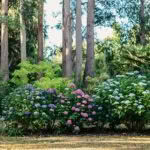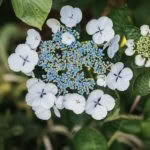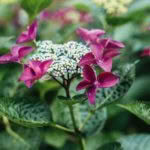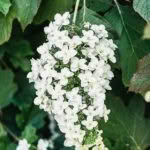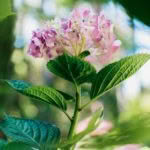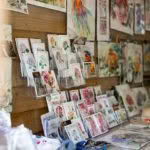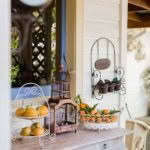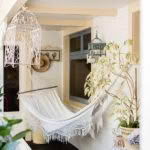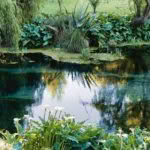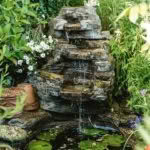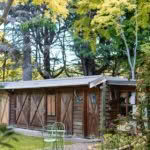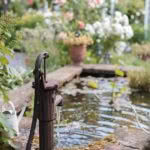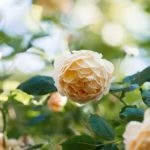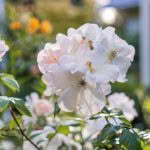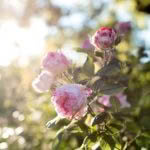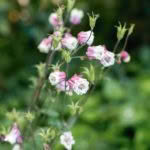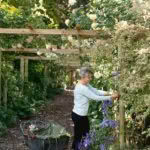Explore Huguette Michel-Fleurie’s Monet-inspired hydrangea garden at Hortensia House in Marlborough
A laissez-faire approach and Monet-inspired palette flow into a magnificent Marlborough garden surrounding a sparkling creek.
Words: Kate Coughlan Photos: Kate MacPherson
Huguette Michel-Fleurie, an alarmingly forthright Frenchwoman, isn’t easily alarmed herself. A ferret attack in the chook house shakes her – but not the imminence of hundreds of visitors about to stream through her property’s stone gates.
“I don’t want to know the things I am supposed to do. I just plant,” she says of the 2ha of garden trailing 100 metres along both sides of Spring Creek and spreading in waves of flowering glory under the canopy of tall trees surrounding Hortensia House.

With the purchase of land across the river four years after their arrival, Huguette Michel-Fleurie initially rowed across to develop the new garden and pond. Building the bridge in a shape which honours her favourite painter Claude Monet, meant significant engineering after the local council required enough height for a boat to pass beneath. Huguette is yet to see a boat, other than her own kayak, on Spring Creek. She encouraged the existing weeping willows and gunnera along the banks but hacked back view-blocking scrub. Plantings of roses ‘Flower Carpet’ (white) and ‘Charlotte’ (yellow), arum lilies and miniature agapanthus allow her to see into the water from the house.
This garden, named after its many hydrangeas, is always a favourite on the Wairau Plains tour during the annual Garden Marlborough festival and has been for many of the festival’s 25 years. The prospect of so many visitors doesn’t bother its owner too much.
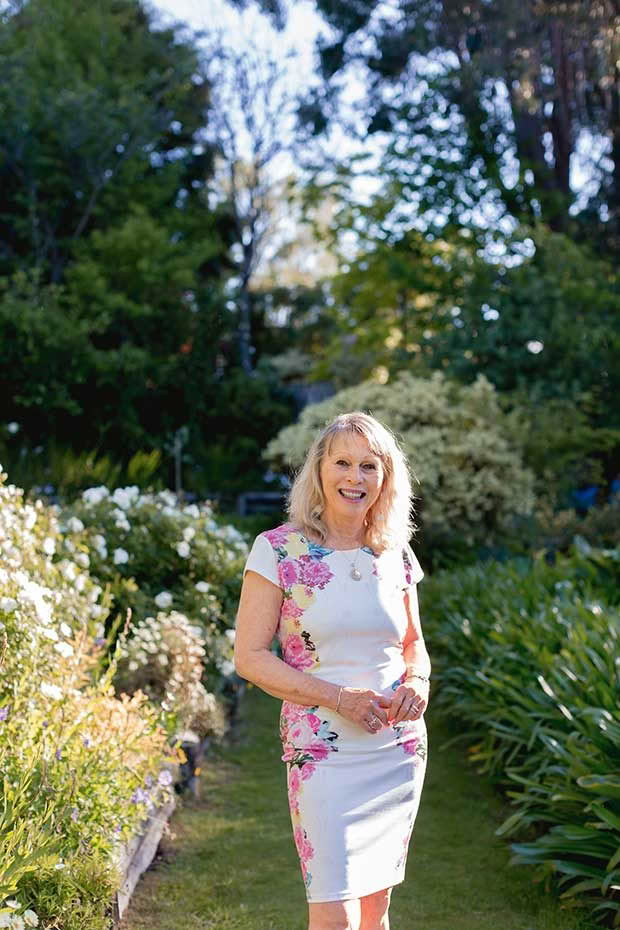
Huguette’s love of growing things and drawing developed in childhood. Initially she drew nudes and portraits in charcoal but she switched to watercolour to better capture the beauty of flowers.
“My girlfriends say, ‘Oh, are you coming to hear the guy talking about compost, and there’s another one talking about landscaping?’ I don’t want to know; I just plant the thing. If they grow and they’re happy, it’s okay. If they die, it’s okay. I will plant something else.”
Huguette says when she first started gardening, she listened to everyone’s advice. “They said: ‘Use these sheep pellets, use this fertilizer, spray here, put in blood and bone there, plant this here, don’t plant that there.’ I said to myself, ‘Oh God, I will just do it my way, the way I like it which is to make it look beautiful, like a picture.’ Now I call myself an ostrich gardener; I keep my head in the sand and I don’t want to know anything.”
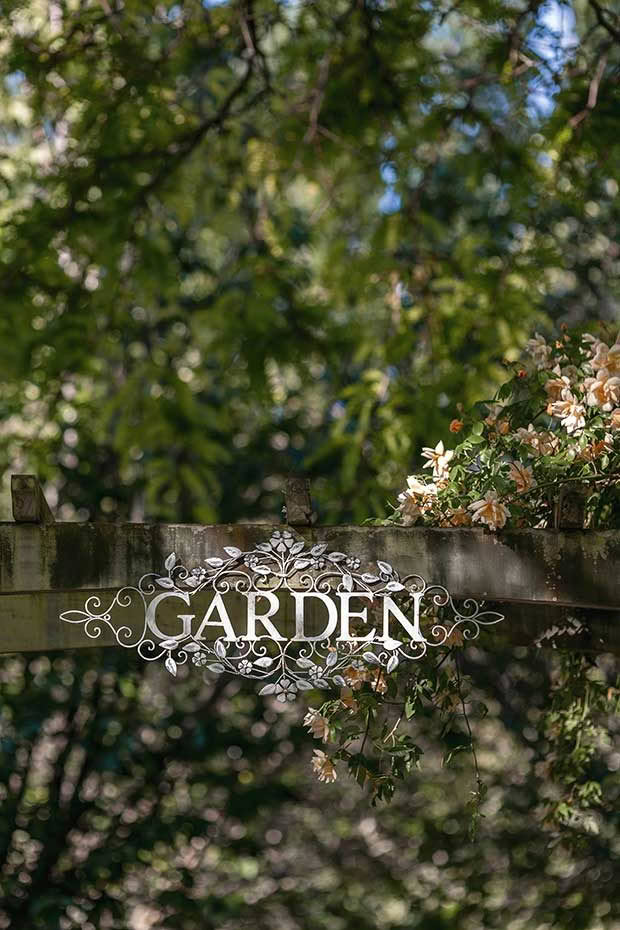
There are so many varieties of hydrangea that Huguette paints the name of each planting on a stone at the foot of the bush.
This laidback approach has not held her back from developing a magnificent garden on an impressive scale and to a high standard but, then again, this artist, grandmother, zumba dancer, tramper and gardener isn’t given to being held back on anything. “I have a limited tolerance for information. I think the secret to having a garden is to plant. I started this garden when I was 45, so I didn’t have all the time in the world to wait for perfection. I just plant, and plant, and plant.”
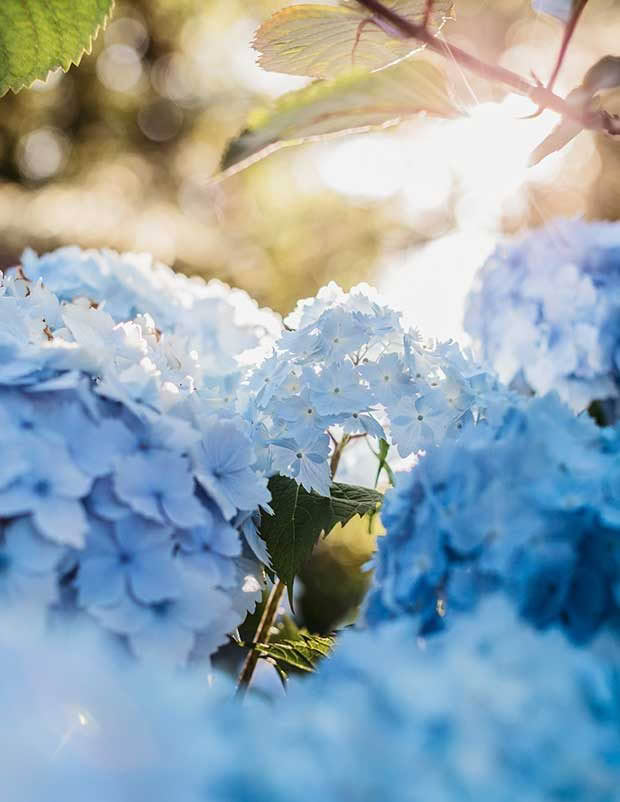
‘Blue Deckle’ (a lacecap) is one of her favourites in the hydrangea family.
Huguette says she buys cheap plants, or swaps them, and then gets them in the ground. “You never know what’s around the corner and anyway, it’s a lot easier to cut out than to grow. When I notice something is not happy, I get rid of it.”
Huguette and her French-born husband, Georges Michel, emigrated from the Reunion Islands (a French department in the Indian Ocean) arriving in Marlborough in 1999. The couple had visited New Zealand five years earlier with their two then-teenage children – daughter Swan and son Naik. That trip didn’t get off to a good start with Huguette’s meltdown in the airport carpark when she saw the vehicle in which they were supposed to travel.
- Beneath the statuesque trunks of the gums (from left) are ‘Jokasaki’, ‘Red Star’ (blueish here), ‘Mrs Kumiko’ (pink) and tall, waxy ‘Ayesha’.
- ‘Saturn’ that is sometimes reddish with blue spots.
- Blue Wave’ with round white petals.
- The lacecap ‘Red Start’.
- Quercifolia ‘Snowflake’.
- The pink flower is variety unknown.
“It was the first time in my life I had seen such a tiny campervan and I said: ‘No, NO, no way am I going to stay a month in this little thing’ but when we got back to Auckland after the trip I cried, because the campervan was so cosy and we had fallen in love with New Zealand – and then we decided to move here.”
Even before the couple had landed in the country, Georges (a former owner of the Château de Grandmont vineyard in Burgundy) had purchased land on which to plant grapes. It may have been the famed Marlborough terroir that attracted Georges but it was photographs of Spring Creek – one of the jewels of the Wairau Valley if not the entire country – to which Huguette was drawn.
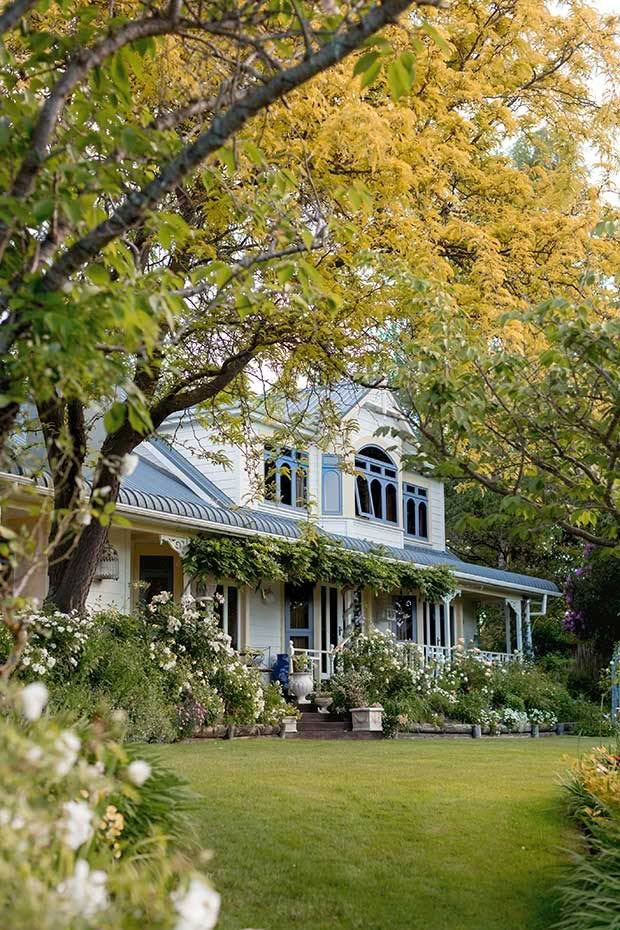
The original brick-red house has vanished under a makeover designed to create a Victorian villa – a style Huguette admired as she toured the country on her first visit. The bullnose verandah which wraps around the house on three sides provides many sitting spots from which to catch glimpses of the garden, sheltered from the wind or sun.
This creek is so clear it’s possible to see the gills of resting trout waving in its depths. Crystal-clear is no cliché; as Huguette’s kayak paddle dips in and out of the water on her early-morning outing, showers of diamond-bright droplets sparkle across its surface keeping this island-born woman happy. Water is important to her. She’d grown up living by the sea in Reunion Island, a remote outpost of France (despite being 9000km from the mainland) to the east of Madagascar. So it was the creek that drew her to the property. Back then, the house was red brick and much smaller and the garden was also quite small.
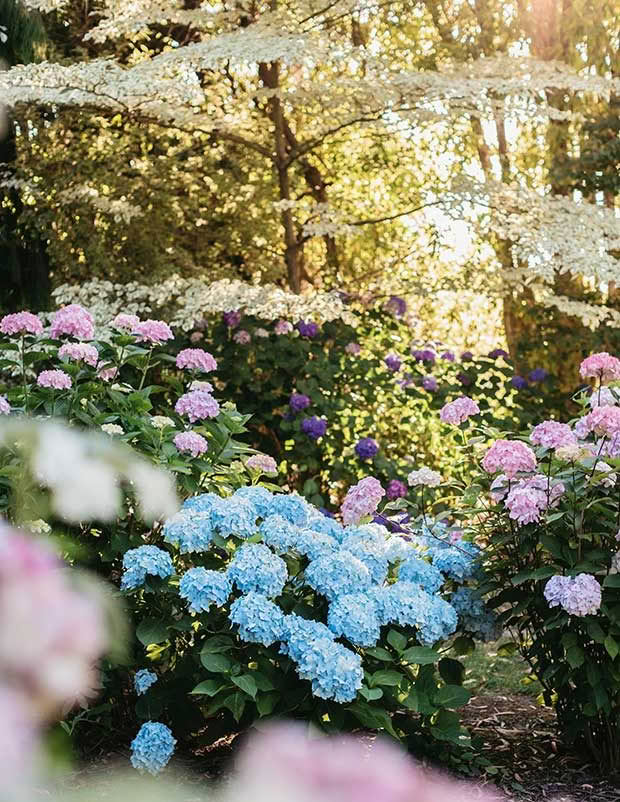
A wedding cake tree, the giant dogwood Cornus controversa ‘Variegata’ provides lovely dappled light in which the hydrangea can shine. The purple hydrangea in the background is ‘Piamina’, the pink on the right is ‘Sabrina’ (recognizable from its reddish stems) the pink on the left is ‘Preziosa’, and the blue mophead centre front is ‘Arthur Billard’.
The results of nearly two decades of gardening reflect her painterly eye with its Monet-inspired palette of cornflower blue and pale buttercup yellow, and the Giverny-like bridge rising in an elegant arch over the creek to a lily pond and rotunda.
The extensive planting of hydrangeas, after which the garden is named (hortensia means hydrangea in French) also reminds Huguette of her island home where hydrangeas were considered very exotic.
- uguette’s great-grandmother, who lived with her until she was nearly 100 years old, had many beautiful souvenir postcards and illustrated Victorian photo albums which Huguette loved.
- Her postcards and paintings are only available for sale in the garden.
- “I looked at lots of books to teach myself to paint but watercolour is not so easy to do precisely. It was trial and error for me but I kept on trying until I found my own way.”
- Huguette says the outdoor kitchen is perfect for any messy cook – not mentioning names but maybe if a cook was fond of making their own sausages, for example, it’d be a good place to do it.
- this hammock was Huguette’s favourite spot when pregnant with her daughter, Swan, and she still retreats to it for summer reading.
- Freya is currently the “Miss No NO” of the family – even though they try to teach her “oui” all she says is “no”.
- The five-metre deep verandahs provide as much living space as the inside of the house.
“They only grew high in the mountains and when I came to New Zealand they were everywhere; I fell in love with them. Hydrangea quercifolia ‘Snowflake’ was my first one. It has oak-shaped leaves and is a double white – it is beautiful.”
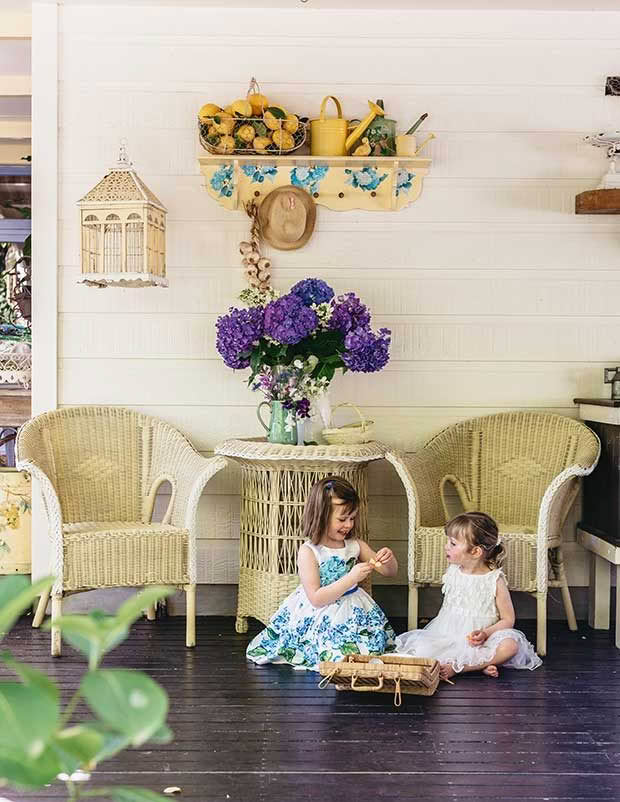
Aria and her younger sister, three-year-old Freya, come to visit twice a week while their mother Swan, a winemaker, is at work at Georges Michel Wine Estate.
Since that first hydrangea, Huguette has planted so many she has no idea of the garden’s total today. As she plants, she writes the name of the variety on a flat riverstone and places the stone in front of each bush, so she knows which varieties she really likes and will plant more of. Those she doesn’t will get the chop. She’s a ruthless gardener who likes to give her plants a ferocious hack from time to time to keep them in line.
- pring Creek flows on the northern side of the property, and in the more shaded east is Huguette’s potting and painting shed.
Nowadays, she propagates most of her own hydrangeas. The spiky-flowering Hydrangea paniculata is one of her favourites. She’s also fond of various moptop and lacecap varieties such as ‘Sabrina’, ‘Goldonia’ and the attractive black-stemmed ‘Nigra’ as well as ‘Merveille Sanguine’ with its gorgeous blood-red flowers. One of her all-time favourites is the Hydrangea sinensis.
In all her planting – and this extensive garden includes everything from forest giants such as rimu, totara, pin oak and copper beech to specimen trees paulownia, gleditsia, philadelphus, gordonia and catalpa, to many roses (firm favourite for her extensive arches is ‘Pierre de Ronsard’ for its disease-resistance and flowering exuberance), masses of irises and every sort of annual and perennial – she has never felt burdened by it. This despite doing it all herself.

The pond by the water pump is home to many friendly frogs, as is Spring Creek which continues to draw Huguette and her husband Georges Michel. They often sit on the riverside landing and enjoy wine produced by their own Georges Michel Wine Estate label. They grow and produce sauvignon blanc, chardonnay, viognier, pinot noir and syrah. Huguette gifts all the income from the garden (including entrance fee and weddings) to the Blenheim Cancer Society and the Malaghan Institute of Medical Research in Wellington. “The donation is good motivation to keep going and gardening helps me keep fit otherwise I can be lazy.”
“I look after my granddaughters two days a week, I go tramping every Wednesday, I paint and one day a week I spend in the garden. The only thing I don’t do is the lawns because
I don’t like engines.”
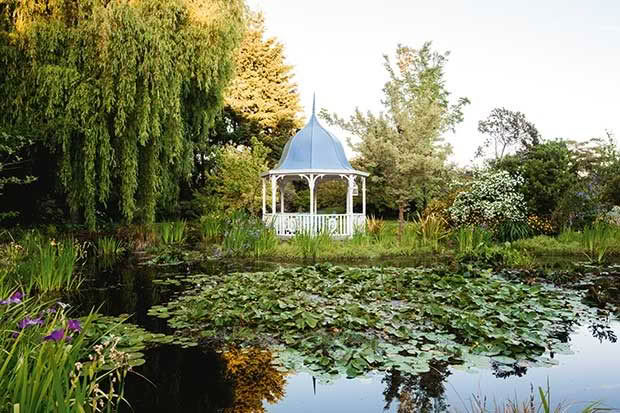
The prefabricated gazebo was imported for the wedding of Huguette’s daughter. Her favourite trees include paulownia, catalpa, philadelphus and gordonia and a native of the Reunion Islands, the strawberry guava (Psidium cattleyanum). “In winter it’s the only fruit in my garden. Today I’ve made guava mousse for dinner and guava icecream for my granddaughters.”
NATURAL JEWEL
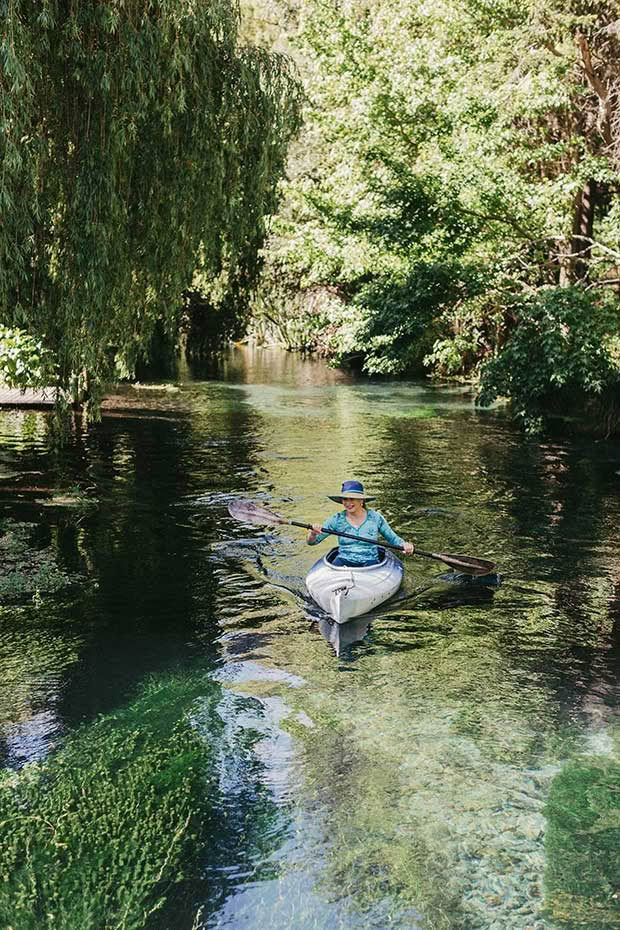
Natural jewel Spring Creek, or Awarua as it is known by local iwi, is the largest spring-fed creek in the Wairau Plains area – the country’s largest grape-growing region.
Crystal-clear water emerges year-round from a series of springs which build the creek’s flow until it joins the Wairau River near Spring Creek township. The underground flow acts as a giant gravel filter removing all impurities. Following European settlement, many of the springs and waterways of the Wairau Plains have been impacted by the intensive agriculture however Spring Creek
still flows in its original course.
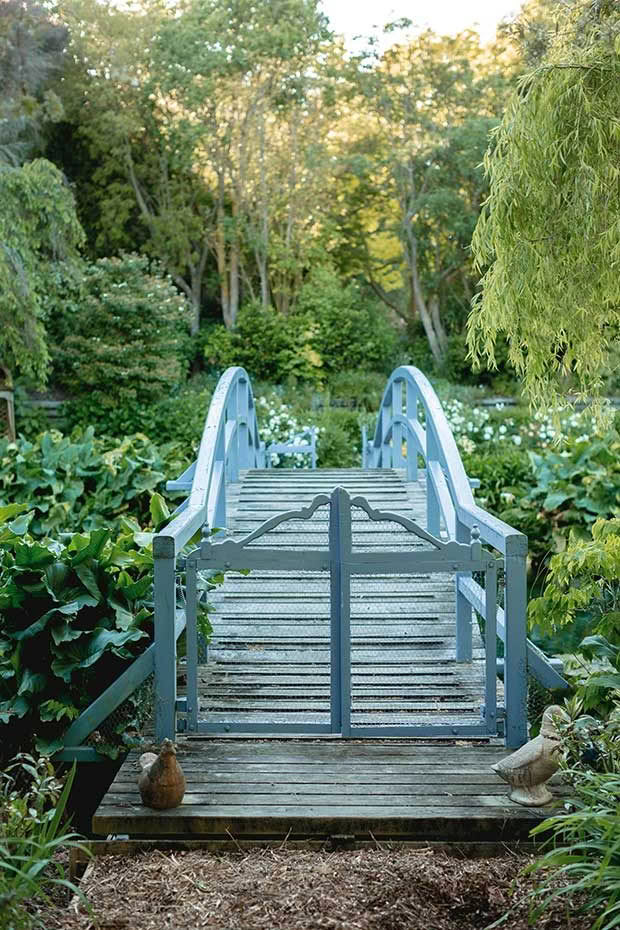
The bridge gates stop the happy hens marching over and helping themselves to the earthly delights of the gardens immediately surrounding the house. Hortensia House is open, by appointment (hortensiahouse.co.nz) from October to April.
It is home to the rare giant kˉokopu, which can live to 20 years and grow to 50cm, and is part of the whitebait species. It is also home to the banded kˉokopu, inanga, lamprey, common bullies, eels, black flounder, brown trout and freshwater mussels and kˉoura (crayfish).
Peter Hamill, team leader for land and water at the Marlborough District Council, says caring for such a precious waterway involves encouraging good cover along the creek edges, letting native plants grow where possible and keeping stock and thus nitrogen runoff away from streams.
VISIT HORTENSIA HOUSE
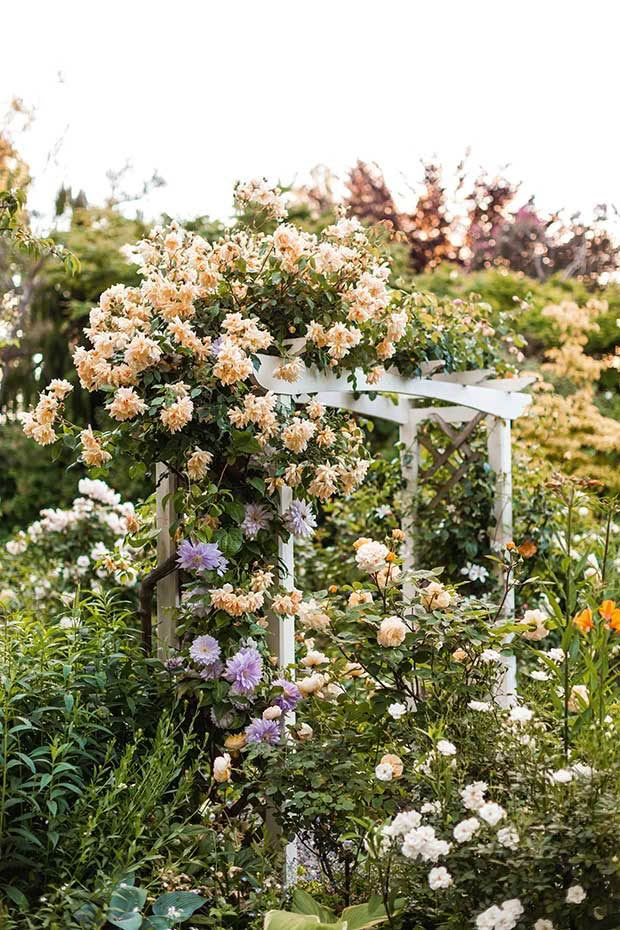
The lovely apricot rose clambering over the arch at the front entrance is ‘Crépuscule’.
This garden is part of Rapaura Springs Garden Marlborough and has been for 17 years. This year the festival runs from 5-8 November.
Tickets at: gardenmarlborough.co.nz
- The delicate roses ‘Golden Celebration’
- ‘Sally Holmes’ roses are among many at the entrance to the house
- ‘Sentimental’ is a delicate pink rose and the aquilegias pop up everywhere in the garden
- The clematis, ‘Belle of Woking’, is a similarly delicate shade but in mauve.
- Huguette manages the Hortensia House gardens by herself saying that her husband, Georges Michel, gets a little grumpy if she asks him to do any gardening. Luckily, he is an expert at mending the irrigation-system sprinklers which Huguette is expert at breaking. She doesn’t like machinery so a man mows the lawns.
Love this story? Subscribe now!
 This article first appeared in NZ Life & Leisure Magazine.
This article first appeared in NZ Life & Leisure Magazine.
